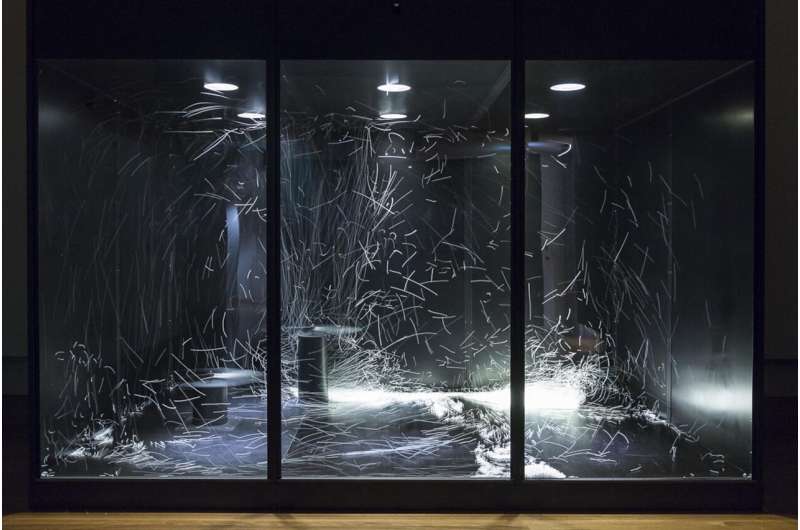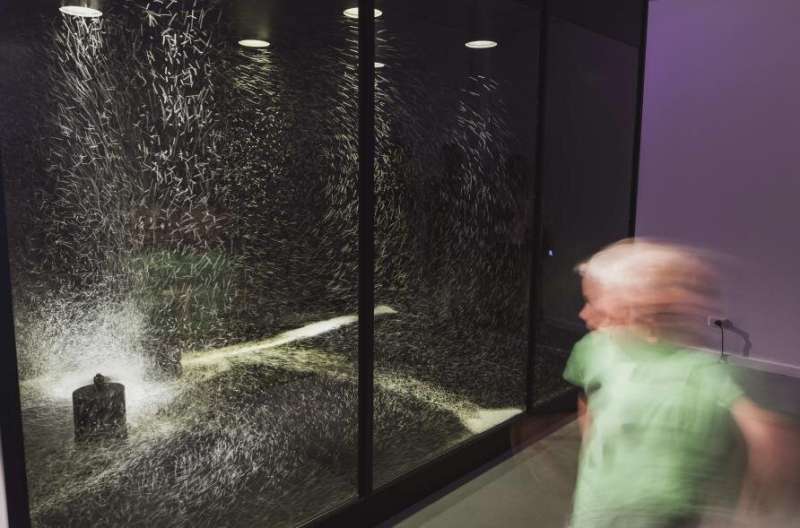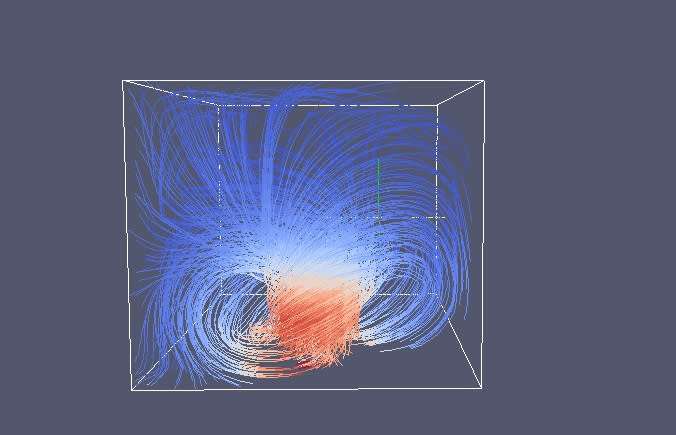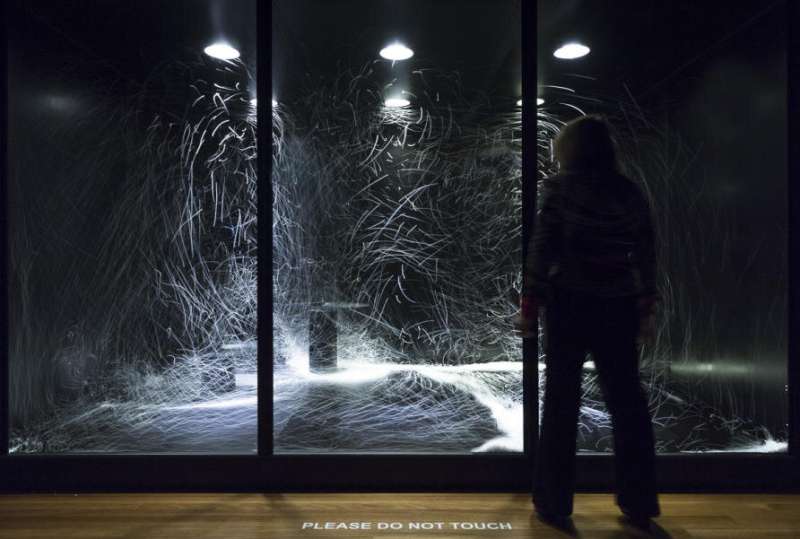A collaboration between art and science explores the turbulent physics of eddies

Many of us as kids have played Poohsticks—throwing a twig into flowing water from a bridge or riverbank and watching it race downstream, but then losing the competition because your stick gets caught in the endless spin of an eddy on the edge of a creek.
On a larger scale, these same eddies or whirlpools have reportedly dragged ships down into a watery grave. But eddies don't only exist in water.
Picture the video of a plastic bag caught in a swirling gust of wind in the film American Beauty, or the cow being dragged through the air in a monster tornado in the film Twister. Imagine the condensed water spiraling off the tips of a fighter jet, or the terrifying jolt as a jumbo jet gets caught in unexpected turbulence.
Eddies are the physical outcome of the movement of fluids (both liquid and gas) and they exist on many scales.
Now, a team of scientists, engineers and artists have come together to produce an art-science experiment, called A Hierarchy of Eddies, which aims to show audiences the complexity of these turbulent systems.
Eddies can be described mathematically using what is called the Navier-Stokes Equation, but the creators of this work say there's something about their evolving shapes that transcends physics or maths and enters the realms of philosophy, psychology and performance.

Led by two long-time collaborators, University of Melbourne astrophysicist Professor Andrew Melatos and artist Briony Barr of Scale Free Network, A Hierarchy of Eddies is currently touring as part of an exhibition, Experimenta Makes Sense: International Triennial of Art, by Melbourne-based arts organisation Experimenta.
The exhibit was created with technical advice from computation fluid dynamics researcher Professor Andrew Ooi from the School of Engineering at the University of Melbourne, and masters student Tony Zahtila.
A Hierarchy of Eddies is, in part, inspired by a quote from English mathematician, physicist, meteorologist, psychologist and poet Lewis Fry Richardson who lived between 1881 and 1953.
Reinterpreting mathematician Augustus De Morgan's rhyme about the biological order of fleas ("Big fleas have little fleas upon their backs to bite 'em / And little fleas have lesser fleas, and so, ad infinitum…"), Richardson wrote:
"Big whorls have little whorls
which feed on their velocity,
And little whorls have lesser whorls
And so on to viscosity."
Ms Barr, who runs Scale Free Network with Dr. Gregory Crocetti, says that the work was also inspired by patterns they had observed in a smaller sculpture they created called the 'particle chamber," which contained a fan and polystyrene balls inside a cabinet with an area of around a metre.
"Early on in the development of A Hierarchy of Eddies, a key scientific and aesthetic question for us was whether a much larger chamber (50 times bigger) containing two fans would exhibit similar emergent patterns, and whether the beauty of the system would be further enhanced by a change in scale," says Ms Barr.
Professor Melatos is a theoretical astrophysicist who was part of the Laser Interferometer Gravitational-Wave Observatory (LIGO) collaboration that in 2015 confirmed the existence of gravitational waves.
But he is also fascinated by what he calls the emergent properties of scientific phenomena—the complex patterns in space and time that arise when simple, fundamental rules are repeated over and over.

"This is an experiment in provocation. Artfully and paradoxically, it invites the viewer to respond to the sight and sound of turbulence in rapidly flowing air by searching for visible and audible patterns in the flow. Where chaos is anticipated, order emerges," he says.
A Hierarchy of Eddies explores the turbulence of eddies using two large fans and ten litres of polystyrene balls enclosed in a glass chamber. Standing on the outside, the audience can watch as the balls are swept into air currents, creating chaotic patterns and shapes in ever-changing whorls.
"The eye is drawn irresistibly to the undulating, strobe-lit motions of the beads surfing an elevated stream of air, or 'chasing their tails' around a miniature tornado near the floor. There is something choreographed about the scene, yet the choreography isn't of the designer's making.
"It reflects the internal, two-sided logic of the system: the turbulent flow, with its intrinsic tendency towards oscillation and vorticity, and the viewer, engaging intimately with the flow, impelled by the universal human instinct to discern patterns," says Professor Melatos.
According to both the artist and the astrophysicist, the particle chamber is both artifact and performance. Its medium is air. Its motive forces are pressure and viscosity.
But they say temperature and humidity are also key factors. Imagine repeating the experiment in a tank of water. Would anything be different? What about a tank of honey or motor oil?

The viscosity of the air determines the "texture" of the turbulence—the degree to which the air streams are tangled, the ease with which they mix and dissipate—just like the viscosity of paint affects the texture of a canvas. The fans resemble outsized brushes, whose sweeping strokes imprint eddies on the flow.
The work is dynamic and unpredictable. Framed by its container and lit by the strobe, it also presents itself to the viewer as an experiment in drama.
"The beads trace the flow passively, but the air itself—the lead protagonist—is alive and expressive and capable of response," says Professor Melatos.
"Through viscosity and nonlinear forces, the air translates the pressure produced by the fans into complex, turbulent eddies at all length-scales, from the small to the large. In this respect, the particle chamber is both theatrical performance and archetypal out-of-equilibrium system."
But the work is also about the relationship between the viewer and the artwork.
According to Professor Melatos, each viewer's experience of the tableau is unique. In this way, the collaboration blurs the line between artistic representation and scientific emulation.
"It provokes the viewer to do their own experiment into the mysteries of far-from-equilibrium pattern formation. It opens the door between studio and laboratory and encourages free passage."
Provided by University of Melbourne




















